1 Employment improved in 2011
1.1 Number of employed persons grew from previous year
According to Statistics Finland’s Labour Force Survey, employment rate rose slightly in 2011. At 68.6, the employment rate for the population aged 15 to 64 was 0.8 percentage points higher than in 2010. Men’s employment rate was 69.8 per cent and women’s 67.4 per cent. Men’s employment rate went up by 1.1 percentage points and women's by 0.5 percentage points from 2010 (Figure 1).
Figure 1. Employment rates by sex in 1989–2011, persons aged 15 to 64, %
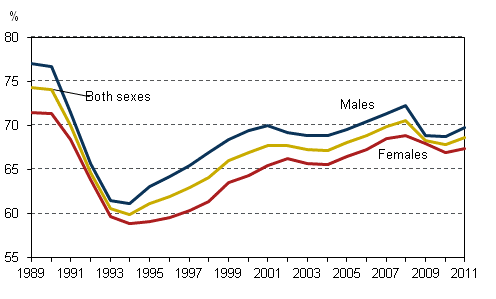
There were 2,474,000 employed persons in 2011, which was 26,000 more than in 2010. However, the number of employed persons was still lower than in 2008 (Figure 2). Employment improved in all quarters of 2011 when compared to 2010.
Figure 2. Number of employed persons by sex in 1989–2011, persons aged 15 to 74
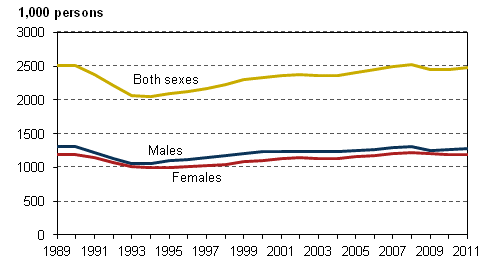
There were 2,143,000 employees in 2011, which was 23,000 more than in the previous year. The number of self-employed persons fell in 2010 but grew slightly in 2011. There were 319,000 self-employed persons and 12,000 assisting family members in 2011. The average share of all self-employed persons among employed persons was 13.4 per cent.
1.2 Men’s employment situation improved further
Men’s employment rate grew further from 2010. Figure 3 shows a time series on changes in the number of employed persons by sex. The number of employed men fell sharply in 2009 but then turned towards slight growth in 2010. In 2011, men’s employment grew by 19,000 persons from 2010. The number of employed women went up by 7,000 in 2011.
Figure 3. Change from the previous year in the number of employed persons by sex in 1991–2011, persons aged 15 to 74
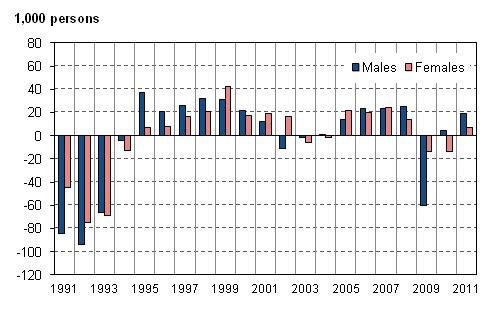
1.3 Employment grew slightly in all age groups
The rate of employment went up in most 10-year age groups in 2011 (Figure 4).
The number of the employed grew most (by 9,000) in the 15 to 24 age group. In the oldest age group of 65 to 74, the number of employed persons was 8,000 higher than in the year before. The size of population in this age group has also grown.
Figure 4. Employment rates by age group in 1989–2011, %
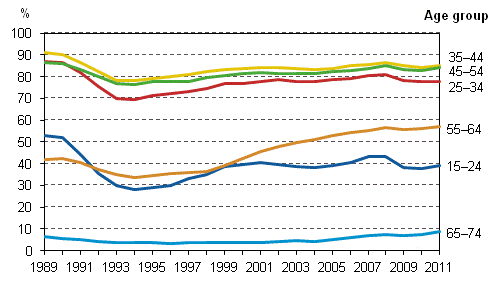
1.4 Employment improved especially in human health and social work activities
Figure 5 shows change from the previous year in the number of employed persons by industry in 2010 and 2011. In human health and social work activities (Q), the number of employed persons grew by 17,000 in 2011, whereas in the previous year it fell by 10,000. In manufacturing (C–E), the decline in the number of employed persons slowed down from 2010. In the activity of transportation and storage (H), the number of employed persons grew slightly in 2010 but fell by 9,000 in 2011.
Figure 5. Change from the previous year in the number of employed persons by industry in 2010–2011, persons aged 15 to 74
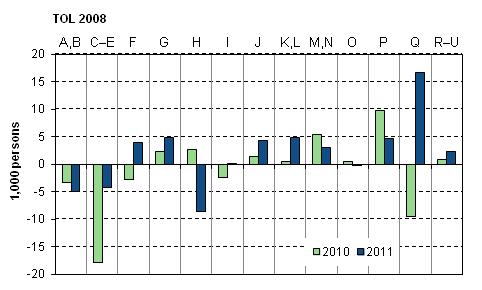
Industries (Standard Industrial Classification TOL 2008)
| A, B | 01–09 | Agriculture, forestry and fishing; mining and quarrying |
| C-E | 10–39 | Manufacturing; electricity, gas, steam and air conditioning and watersupply; sewerage and waste management |
| F | 41–43 | Construction |
| G | 45–47 | Wholesale and retail trade; repair of motor vehicles and motorcycles |
| H | 49–53 | Transportation and storage |
| I | 55–56 | Accommodation and food service activities |
| J | 58–63 | Information and communication |
| K, L | 64–68 | Financial, insurance and real estate activities |
| M, N | 69–82 | Professional, scientific and technical activities; administrativeand support service activities |
| O | 84 | Public administration and defence; compulsory social security |
| P | 85 | Education |
| Q | 86–88 | Human health and social work activities |
| R–U | 90–99 | Arts, entertainment and recreation; other service activities |
Employment increased mainly in the private sector, which employed 22,000 persons more than in 2010. In the public sector, the number of the employed grew slightly in the local government sector.
1.5 Number of hours actually worked remained almost unchanged
A total of 4.0 billion hours were worked in the national economy in 2011. The number of hours actually worked was 0.9 per cent higher in 2011 than in 2010. The number of hours actually worked per employed person remained almost unchanged from the previous year. In 2010, the average annual number of hours actually worked by an employed person was 1,634, whereas in 2011 the respective figure was 1,631.
There were fewer underemployed persons in 2011 than in the year before. While in 2010 underemployed persons numbered 120,000, in 2011 their number fell to 113,000. Underemployed persons refer to persons working involuntarily e.g. part-time or a shortened working week.
Source: Labour Force Survey 2011. Statistics Finland
Inquiries: Kirsi Toivonen 09 1734 3535, Olga Kambur 09 1734 3565, Tarja Nieminen 09 1734 3561, tyovoimatutkimus@stat.fi
Director in charge: Riitta Harala
Updated 9.3.2012
Official Statistics of Finland (OSF):
Labour force survey [e-publication].
ISSN=1798-7857. Employment and unemployment in 2011 2011,
1 Employment improved in 2011
. Helsinki: Statistics Finland [referred: 27.12.2025].
Access method: http://stat.fi/til/tyti/2011/13/tyti_2011_13_2012-03-09_kat_001_en.html

